Psych - Trait & Biological
0.0(0)
0.0(0)
Card Sorting
1/106
Earn XP
Study Analytics
Name | Mastery | Learn | Test | Matching | Spaced |
|---|
No study sessions yet.
107 Terms
1
New cards
Trait
Consistent pattern in the way individuals behave, think and feel
2
New cards
“Trait” implies…consistency and distinctiveness
* describes irregularly in a person's behaviors
* Collection of traits that define/describe and individual = disposition
* Predispose us to act in a certain way
* Concern with the traits by which people differ
* Theorists do a lot of defining and identifying what traits are
* Also interested in measurement
* Personality inventories/tests
* Identification of individual’s traits and provision of accurate description of person’s personality based on those traits
* Collection of traits that define/describe and individual = disposition
* Predispose us to act in a certain way
* Concern with the traits by which people differ
* Theorists do a lot of defining and identifying what traits are
* Also interested in measurement
* Personality inventories/tests
* Identification of individual’s traits and provision of accurate description of person’s personality based on those traits
3
New cards
Traits function to:
* describe (taxonomy) - scientific way of classifying things
* Goal is to identify the smallest number of traits that are possessed by everyone
* Predict
* With knowledge about a person’s traits -> should be able to predict how someone with be like in a particular situation or in general
* Strength of these traits among individual varies and thus the individuals with behave differently
* explain\*
* \*not all trait theorists are concerned with this…
* Majority are most interested in describing and predicting
* Some suggest that traits can be used to explain a person’s behavior
* Goal is to identify the smallest number of traits that are possessed by everyone
* Predict
* With knowledge about a person’s traits -> should be able to predict how someone with be like in a particular situation or in general
* Strength of these traits among individual varies and thus the individuals with behave differently
* explain\*
* \*not all trait theorists are concerned with this…
* Majority are most interested in describing and predicting
* Some suggest that traits can be used to explain a person’s behavior
4
New cards
Trait =
* Consistency
* Stability
* Stability
5
New cards
State =
* Has to do with a particular situation
* Emotional experience of a person
* Mood of a person
* Immediate situation of a person
* How our traits express themselves differently based on the state we are in
* Emotional experience of a person
* Mood of a person
* Immediate situation of a person
* How our traits express themselves differently based on the state we are in
6
New cards
Activities =
* Things you can observe
* Some say you can infer from observable actions how one behaves and what traits they have that results in their behavior
* Might reflect traits, but might reflect state
* Some say you can infer from observable actions how one behaves and what traits they have that results in their behavior
* Might reflect traits, but might reflect state
7
New cards
Roles =
* In different roles that an individual is in, their traits will present differently
* Determines how we behave, think and feel
* Determines how we behave, think and feel
8
New cards
Gordon Allport (1897 - 1967)
* Book had huge impact on the study of personality psychology
* Father of personality psychology
* Spent most of academic career at Harvard
* Humanistic view: person in state of “becoming”
* Was trained as a Freudian
* Emphasis on the individual’s **unique** behaviors and thoughts
* internal , motivation and cognitive concerns as well
* Believed personality was jointly caused by biology and psychology
* Father of personality psychology
* Spent most of academic career at Harvard
* Humanistic view: person in state of “becoming”
* Was trained as a Freudian
* Emphasis on the individual’s **unique** behaviors and thoughts
* internal , motivation and cognitive concerns as well
* Believed personality was jointly caused by biology and psychology
9
New cards
Allport’s Trait Theory
* Traits are neuropsychic structures
* Located in a part of our nervous system
* Can infer they are via the expression of those traits
* Couldn’t prove their “physical” existence
* Traits can initiate and guide consistent forms of adaptive and expressive behavior
* Traits are common or personal
* Much more interested in the personal traits
* Can be studied by nomothetic (standardized measures) or idiographic (flexible measures) methods
* preferred idiographic method
* Located in a part of our nervous system
* Can infer they are via the expression of those traits
* Couldn’t prove their “physical” existence
* Traits can initiate and guide consistent forms of adaptive and expressive behavior
* Traits are common or personal
* Much more interested in the personal traits
* Can be studied by nomothetic (standardized measures) or idiographic (flexible measures) methods
* preferred idiographic method
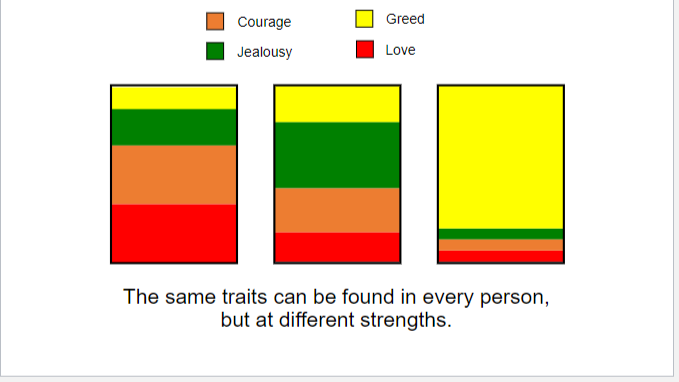
10
New cards
Allport on trait consistency
* Recognized importance of the situation
* Traits explain consistency
* Situation explains variability
* Traits explain consistency
* Situation explains variability
11
New cards
Cardinal Traits
* Pervasive and dominant
* Pervasive: affect every aspect of our lives
* Dominant: very very strong, very important in terms of defining our personality
* “Master motives”
* “Ruling passions”
* Define what we find interesting, stimulating and gravitate towards
* Pervasive: affect every aspect of our lives
* Dominant: very very strong, very important in terms of defining our personality
* “Master motives”
* “Ruling passions”
* Define what we find interesting, stimulating and gravitate towards
12
New cards
Central Traits
important, but control less of one’s behavior; typical descriptors
* Cover more limited amount of situations than cardinal traits
* More changeable, malleable
* Cover more limited amount of situations than cardinal traits
* More changeable, malleable
13
New cards
Secondary Traits
less important or conspicuous
14
New cards
Personality Development
* Concept of the “self”
* Uniqueness of the individual
* Functional autonomy (ideally)
* if the motive is functionally autonomous, the individual is doing that because they want to do that and it expresses a part of their personality
* behavior based on present interests and conscious decisions
* Behaviors not traceable to childhood experiences
* Early development: peripheral motives and guided by tension reduction
* Dependence on other people, means to enhance survival through meeting needs
* Adult life: shift toward self-strivings
* Doing things because it's what we consciously chose to do
* Influence by our personality traits
* Uniqueness of the individual
* Functional autonomy (ideally)
* if the motive is functionally autonomous, the individual is doing that because they want to do that and it expresses a part of their personality
* behavior based on present interests and conscious decisions
* Behaviors not traceable to childhood experiences
* Early development: peripheral motives and guided by tension reduction
* Dependence on other people, means to enhance survival through meeting needs
* Adult life: shift toward self-strivings
* Doing things because it's what we consciously chose to do
* Influence by our personality traits
15
New cards
Allport’s Legacy
* Valued contributions to personality & trait theory
* Lack of explanation for traits
* Research concerns:
* No clear trait/situation link
* No support for claim of hereditary influence
* Over-reliance on idiographic methods
* All other trait theorists have endeavored to establish a set of traits possessed by every person to some degree
* Lack of explanation for traits
* Research concerns:
* No clear trait/situation link
* No support for claim of hereditary influence
* Over-reliance on idiographic methods
* All other trait theorists have endeavored to establish a set of traits possessed by every person to some degree
16
New cards
Raymond Cattel (1905 - 1998)
* London scientist
* Research assistant for Spearman
* Spent time at Columbia
* *Factor analysis method*
* __Surface traits__
* __Source traits__
* Research assistant for Spearman
* Spent time at Columbia
* *Factor analysis method*
* __Surface traits__
* __Source traits__
17
New cards
Surface Traits
* ‘on the surface’; behavioral tendencies
* Visible, observable in behaviors
* Visible, observable in behaviors
18
New cards
Source Traits
* internal psychological structures that are the underlying cause of intercorrelations of surface traits
19
New cards
Surface and Source Trait Relationship
* A few source traits can create what seem to be many ‘different’ surface traits
* A factor analysis of surface traits can reveal their underlying source traits
* A factor analysis of surface traits can reveal their underlying source traits
20
New cards
Factor Analysis
* A statistical tool for summarizing the ways in which a large number of variables are correlated
* Premier tool used by trait theorists to identify the structures of personality
* Premier tool used by trait theorists to identify the structures of personality
21
New cards
Correlation Coefficient
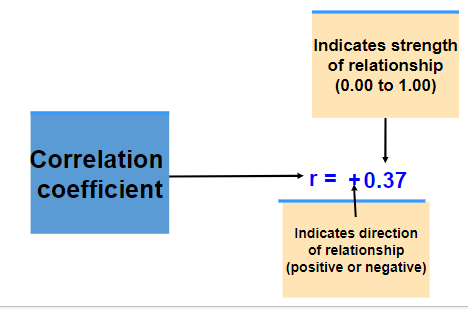
22
New cards
Factor Analysis: Step 1
Collect surface trait ratings from many people
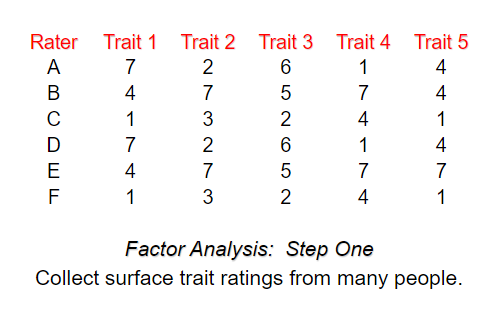
23
New cards
Factor Analysis: Step 2
Calculate correlations among those ratings

24
New cards
Factor Analysis: Step 3
Extract factors from the correlation matrix
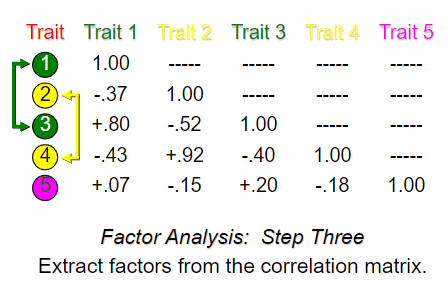
25
New cards
Factor Analysis: Step Four
Calculate factor loadings
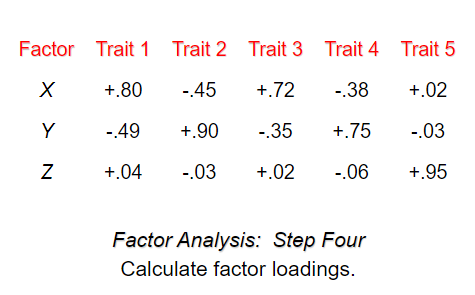
26
New cards
Factor Analysis: Step 5
Review the loadings and name the factors
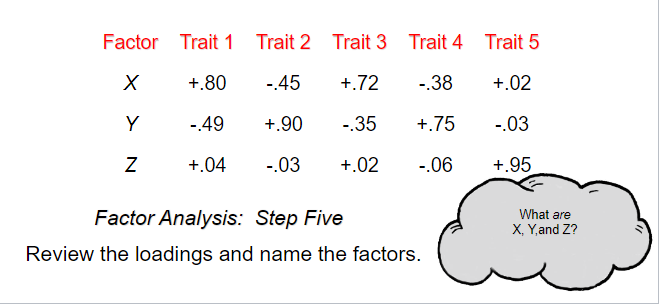
27
New cards
Factor Analysis: Step 2 example
calculate correlations among items

28
New cards
Factor Analysis: Steps 4 & 5 example
4: loading of 6 items on 2 factors
5: name the factors
5: name the factors
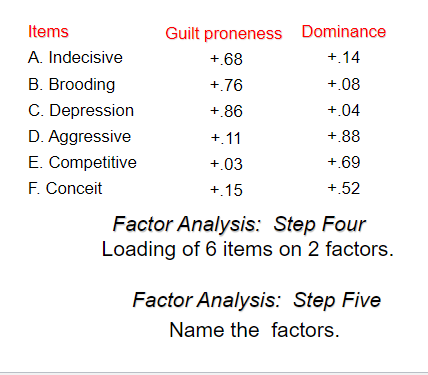
29
New cards
Factor Analysis Benefits
* Reduces the multiple reflections of personality to a smaller set of traits.
* Provides a basis for arguing that some traits matter more than others.
* Helps in developing assessment devices.
* Provides a basis for arguing that some traits matter more than others.
* Helps in developing assessment devices.
30
New cards
Cattel: 3 categories of source traits
* __Ability traits__
* __Temperament traits__
* __Dynamic traits__
* __Temperament traits__
* __Dynamic traits__
31
New cards
Ability Traits
skills that allow the individual to function effectively
32
New cards
Temperament Traits
traits involved in emotional life
33
New cards
Dynamic traits
traits involved in motivational life
34
New cards
The Five Factor Model
Openness to experience
Conscientiousness
Extraversion
Agreeableness
Neuroticism
* Considered good theory but not perfect
* An adequate number of traits/factors to describe everyone’s personality
* Each one of us possesses each of these traits on a continuum
Conscientiousness
Extraversion
Agreeableness
Neuroticism
* Considered good theory but not perfect
* An adequate number of traits/factors to describe everyone’s personality
* Each one of us possesses each of these traits on a continuum

35
New cards
The Big Five Trait Factors and Scales
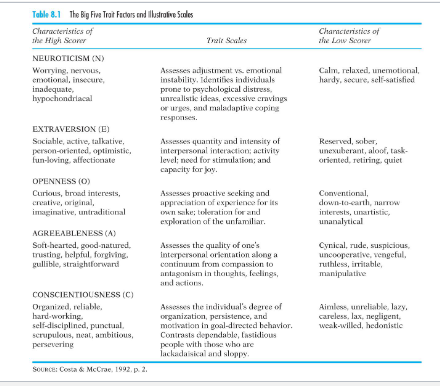
36
New cards
Cross-Cultural Research
Cross-Cultural Research
Are the Big Five universal? Methodological issue: translation
* DiBlas & Forzi, 1999
* E, A & C replicated in Italian
* DeRaad & Peabody, 2005
* E,A, C “cross-lingually recurrent”
Costa and McCrea: Big five structure is a human universal
Are the Big Five universal? Methodological issue: translation
* DiBlas & Forzi, 1999
* E, A & C replicated in Italian
* DeRaad & Peabody, 2005
* E,A, C “cross-lingually recurrent”
Costa and McCrea: Big five structure is a human universal
37
New cards
NEO Personality Inventory (Neo-PI-R)
* Primary assessment tool to assess the traits in an individual
* Measures five factors & six ‘facets’
* Good reliability & validity
* Reliability: consistent results
* Validity: measures what it says it measures
* Agrees with other Big Five instruments
* If someone takes it and another assessment tool that measures the big five the results will be similar
* Correlates with Eysenck’s inventories & Cattell’s 16 factors
* Measures five factors & six ‘facets’
* Good reliability & validity
* Reliability: consistent results
* Validity: measures what it says it measures
* Agrees with other Big Five instruments
* If someone takes it and another assessment tool that measures the big five the results will be similar
* Correlates with Eysenck’s inventories & Cattell’s 16 factors
38
New cards
Big Five - Six Facets
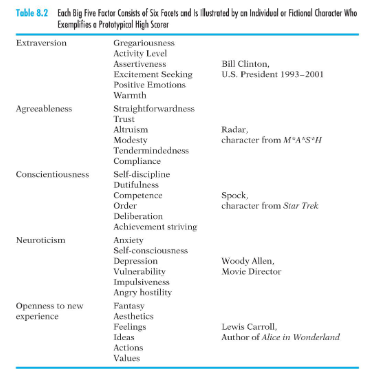
39
New cards
Integration of Theories
* Eysenck’s Extraversion and Neuroticism virtually identical to Extroversion and Neuroticism dimensions of Big Five
* Eysenck’s Psychoticism corresponds to combination of Low Conscientiousness + Low Assertiveness
* NEO-PI-R relates meaningfully with Q-Sort
* Eysenck’s Psychoticism corresponds to combination of Low Conscientiousness + Low Assertiveness
* NEO-PI-R relates meaningfully with Q-Sort
40
New cards
Costa and McCrea: Big Five more than descriptors
* Each factor is a universal structure
* Everyone has each psychological structure (trait) in varying amounts
* Psychological structures (traits) causally influence psychological development
* How we develop psychologically is due in part to the strength of these particular traits
* Everyone has each psychological structure (trait) in varying amounts
* Psychological structures (traits) causally influence psychological development
* How we develop psychologically is due in part to the strength of these particular traits
41
New cards
Costa and McCrea beliefs
* Factors have a biological basis
* Differences linked to the Big Five determined by genetic influences on neural structure & brain chemistry
* The five traits are *not influenced by the environment*; strongest “nature” position possible
* Differences linked to the Big Five determined by genetic influences on neural structure & brain chemistry
* The five traits are *not influenced by the environment*; strongest “nature” position possible
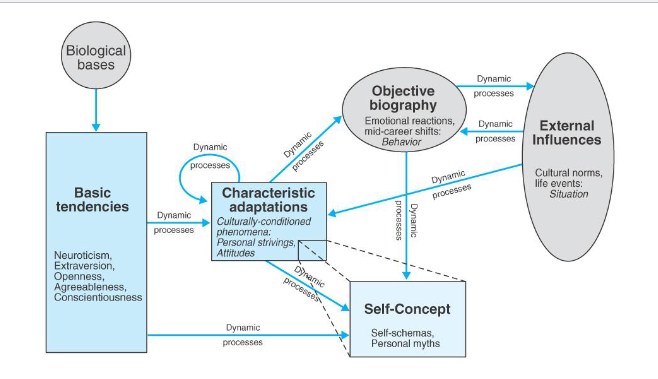
42
New cards
Problematic Issues (Five Factor)
1. How to link personality structures to personality processes
1. Response: those are to be filled in by different theorists
2. Claim that traits are not affected by social factors
1. There is research that directly challenges this assertion
3. Five-factor theory claims everyone has all five factors
43
New cards
Growth and Development: longitudinal research
* Evidence of stability over long time periods
* Significant correlations among repeated measures
* Change evident, despite stability
* Greater stability in adulthood than in childhood
* Significant correlations among repeated measures
* Change evident, despite stability
* Greater stability in adulthood than in childhood
44
New cards
Growth and Development
* What accounts for differences across the lifespan?
* Personality change?
* Cohort effects?
* Differences in different groups of people
* Cohort: people who “go through life together”
* Different cohorts experience the same events but within the context of the particular cohort
* How particular events affect each cohort are different
* Personality change?
* Cohort effects?
* Differences in different groups of people
* Cohort: people who “go through life together”
* Different cohorts experience the same events but within the context of the particular cohort
* How particular events affect each cohort are different
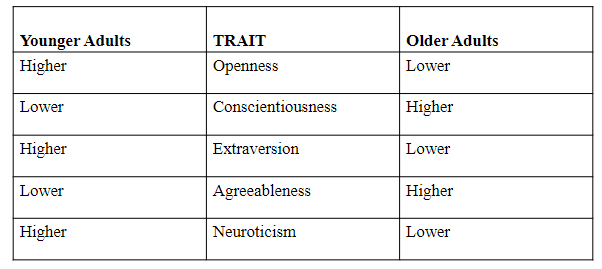
45
New cards
Maybe we missed one? The Six Factor Model
* Big Five model had been consensus since the 1980s
* Sixth factor suggested: honesty/humility
* Sixth factor suggested: honesty/humility
46
New cards
Six Factor Model?
* Individual differences in the tendency to be truthful and sincere vs. cunning and disloyal are a reliable sixth factor
* Validated across 7 languages
* Not yet incorporated into theory or research
* Validated across 7 languages
* Not yet incorporated into theory or research
47
New cards
Evaluation: Trait Theory
* DATABASE: excellent
* SYSTEMATIC: Cattell, yes; Eysenck, so-so; Costa & McCrea, not so much
* TESTABLE: very good
* COMPREHENSIVE: yes & no
* APPLICATIONS: yes, in re: predictions; not strong in re: clinical usefulness
* SYSTEMATIC: Cattell, yes; Eysenck, so-so; Costa & McCrea, not so much
* TESTABLE: very good
* COMPREHENSIVE: yes & no
* APPLICATIONS: yes, in re: predictions; not strong in re: clinical usefulness
48
New cards
Factor Analysis Benefits
* Reduces the multiple reflections of personality (trait terms that you can use to describe somebody) to a smaller set of traits.
* Provides a basis for arguing that some traits matter more than others.
* If a factor accounts more a large amount of variability (load strongly) they are more important
* Helps in developing assessment devices.
* Aim to describe individuals based on trait theory
* Provides a basis for arguing that some traits matter more than others.
* If a factor accounts more a large amount of variability (load strongly) they are more important
* Helps in developing assessment devices.
* Aim to describe individuals based on trait theory
49
New cards
Cattel: 3 categories of Source Traits
* ability traits
* temperament traits
* dynamic traits
* temperament traits
* dynamic traits
50
New cards
Ability Traits (Cattel)
* skills that allow the individual to function effectively
* Success in dealing with the ups and downs of life
* Success in dealing with the ups and downs of life
51
New cards
Temperament Traits (Cattel)
traits involved in emotional life
52
New cards
Dynamic Traits (Cattel)
* traits involved in motivational life
* What propels us to engage in particular activity
* Traits involved in selection and pursuit of activities
* What propels us to engage in particular activity
* Traits involved in selection and pursuit of activities
53
New cards

The 16-PF Test (Cattel)
* Every human being possesses these traits to a certain extent
* Response on test determines where they fall on the continuum of a particular personality factor
* Provide reasonable accurate description of personality
* Benefits: fewer items to assess and terms to identify
* Drawback: may not be entirely comprehensive - many not adequately/accurately describe a personality, things may be missing
* Response on test determines where they fall on the continuum of a particular personality factor
* Provide reasonable accurate description of personality
* Benefits: fewer items to assess and terms to identify
* Drawback: may not be entirely comprehensive - many not adequately/accurately describe a personality, things may be missing
54
New cards
Cattel’s Legacy…
* Strong foundation based on systematic research efforts
* 16 PF continues to be widely used in applied settings
* Work exerts little impact in contemporary personality science
* The 16 factor approach is not parsimonious
* Still too many
* Based his theory on measurement, which is risky
* 16 PF continues to be widely used in applied settings
* Work exerts little impact in contemporary personality science
* The 16 factor approach is not parsimonious
* Still too many
* Based his theory on measurement, which is risky
55
New cards
Hans Eysenck (1916-1997)
* Born in berlin
* Parents well known actors
* Left germany in 1930s after Hitler assumed power
* University of Dijon and then University of London
* Majority of professional life in hospice
* Took factor analytic method further
* 3 factor model
* Emphasized biological foundation of personality
* Parents well known actors
* Left germany in 1930s after Hitler assumed power
* University of Dijon and then University of London
* Majority of professional life in hospice
* Took factor analytic method further
* 3 factor model
* Emphasized biological foundation of personality
56
New cards
Secondary Factor Analysis (Eysenck)
used to identify a simple set of factors that are statistically independent (not correlated with each other)
* Conducted factor analysis and secondary factor analysis
* Re-factor-analyzed the first
* Factors are commonly correlated; intercorrelations among factors can themselves be factor-analyzed
* Conducted factor analysis and secondary factor analysis
* Re-factor-analyzed the first
* Factors are commonly correlated; intercorrelations among factors can themselves be factor-analyzed
57
New cards
Superfactors
* Factor analytic trait dimensions derived from factor analysis
* Highest level of hierarchy of traits
* superfactor
* trait level
* Habitual response level: typical responses
* Specific response level: responses based in specific contexts
* Most people fall somewhere in the middle for most
* Proposed that in addition to the 16PF not being independent, but that individuals who took that test would often end up with scores that correlated with other factors (overlap)
* Highest level of hierarchy of traits
* superfactor
* trait level
* Habitual response level: typical responses
* Specific response level: responses based in specific contexts
* Most people fall somewhere in the middle for most
* Proposed that in addition to the 16PF not being independent, but that individuals who took that test would often end up with scores that correlated with other factors (overlap)
58
New cards
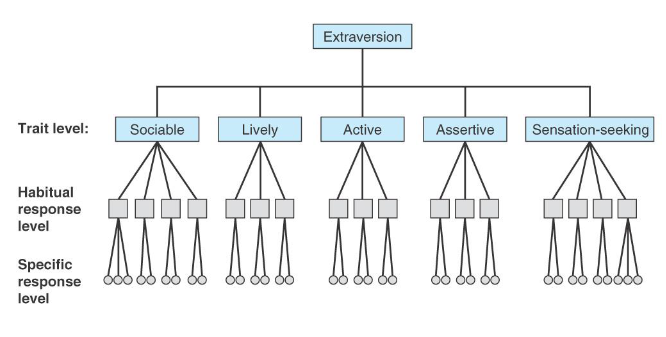
Extraversion (superfactor)
organizes lower-level traits such as sociability, activity, liveliness and excitability
59
New cards
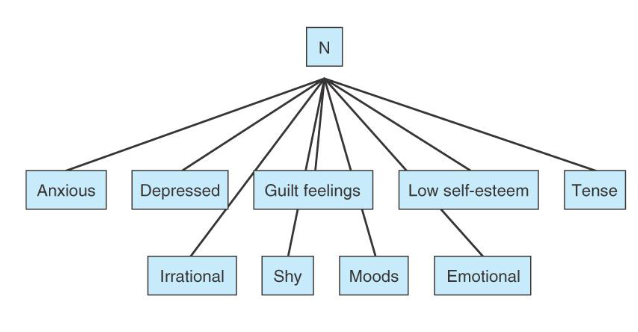
Neuroticism (superfactor)
(emotional stability vs. instability) organizes traits such as anxious, depressed, shy, and moody
60
New cards

General Personality Dimensions
* introversion/extroversion
* emotional stability/instability
* Anyone can be described within this two-dimensional space according to Eysenck
* emotional stability/instability
* Anyone can be described within this two-dimensional space according to Eysenck
61
New cards

Psychoticism (superfactor)
* “abnormal” qualities, including
* aggressiveness, a lack of empathy, interpersonal coldness, and antisocial behavioral tendencies
* Not everyone would have this
* Only comes into play with individuals who display “abnormal” traits qualities
* aggressiveness, a lack of empathy, interpersonal coldness, and antisocial behavioral tendencies
* Not everyone would have this
* Only comes into play with individuals who display “abnormal” traits qualities
62
New cards
Measuring Superfactors
* Eysenck developed simple, self-report items designed to tap each of the factors
* Included “lie scale” items:
* (Yes / No response format)
* Do you sometimes laugh at a dirty joke?
* Did you always do as you were told as a child?
* Included “lie scale” items:
* (Yes / No response format)
* Do you sometimes laugh at a dirty joke?
* Did you always do as you were told as a child?
63
New cards
Objective Measures: The “Lemon Drop Test”
* Introverts & extraverts differ in amount of saliva produced
* Based in reticular activating system
* Introverts = more saliva
* Very sensitive and highly responsive to stimuli
* Extrovert = less saliva
* Need more stimulation
* Suggests a biological basis to individual differences
* Based in reticular activating system
* Introverts = more saliva
* Very sensitive and highly responsive to stimuli
* Extrovert = less saliva
* Need more stimulation
* Suggests a biological basis to individual differences
64
New cards
Individual differences in introversion-extraversion
*Introverts:* more cortical arousal
*Extroverts:* less cortical arousal
*Extroverts:* less cortical arousal
65
New cards
Twin Studies
suggest heredity accounts for some differences in extraversion
66
New cards
Psychopathology (according to Eysenk)
* Neurotic symptoms = biology + environment
* Majority of neurotic patients: high N & low E scores
* Criminals & antisocial persons: high N,E, & P
* Majority of neurotic patients: high N & low E scores
* Criminals & antisocial persons: high N,E, & P
67
New cards
Five Factor Model: “The Big Five”
Evidence-based approach focused on individual differences (Costa & McCrea 1992)
68
New cards
Individual Differences
* “How do people differ from each other?”
* “Is there a set of basic…?”
* Is there a set of factors that can accurately describe everyone’s personality?
* “Is there a set of basic…?”
* Is there a set of factors that can accurately describe everyone’s personality?
69
New cards
Five Factor Model Research Evidence
Factor Analyses of 3 types of data:
Factor Analyses of 3 types of data:
* Trait terms in the natural language
* cross-cultural research
* Relation of trait questionnaires to other questionnaires
* cross-cultural research
* Relation of trait questionnaires to other questionnaires
70
New cards
Temperament - Thomas & Chess (1977)
* Studied infants throughout childhood and adolescence
* Biologically based
* Primarily from developmental psychology
* Individual differences
* How we differ from each other personality-wise
* Emotional & motivational tendencies
* Evident early in life
* Biologically based
* Primarily from developmental psychology
* Individual differences
* How we differ from each other personality-wise
* Emotional & motivational tendencies
* Evident early in life
71
New cards
Longitudinal Study Design
* Allows researchers to determine if psychological qualities in life are enduring over a long period of time
* 2000: 1 year old
* 2007: 7 years old
* 2014: 14 years old
* 2000: 1 year old
* 2007: 7 years old
* 2014: 14 years old
72
New cards
New York Longitudinal Study
* 100 children from birth to adolescents
* Used parental ratings of reactions to different situations (biased)
* Found that temperament styles tended to endure over the growth of the babies
* Having parents rate them on things like, activity level, mood, persistence in task
* Used parental ratings of reactions to different situations (biased)
* Found that temperament styles tended to endure over the growth of the babies
* Having parents rate them on things like, activity level, mood, persistence in task
73
New cards
New York Longitudinal Study Infant Temperament Types - Easy
* playful & adaptable
* Easy to sooth, adapt readily to routines, “go with the flow”
* Easy to sooth, adapt readily to routines, “go with the flow”
74
New cards
New York Longitudinal Study Infant Temperament Types - Difficult
* negative & not adaptable
* Easily upset and not easily calmed, not highly adaptable to routine
* Easily upset and not easily calmed, not highly adaptable to routine
75
New cards
New York Longitudinal Study Infant Temperament Types - Slow to warm up
* low reactivity & mild responses
* More reactive than easy babies but not as reactive as difficult babies
* In between the two
* More reactive than easy babies but not as reactive as difficult babies
* In between the two
76
New cards
“Goodness to fit”
* The particular environments that the caregivers provide are better fits for certain types of temperament styles in babies
* Ex: a difficult baby would do better in a more quiet and calm household environment
* Difficult babies found more trouble adjusting to things later in life, and easy babies had an easier time
* Ex: a difficult baby would do better in a more quiet and calm household environment
* Difficult babies found more trouble adjusting to things later in life, and easy babies had an easier time
77
New cards
Buss & Plomin (1984) - Dimensions of Temperament
* Used parental ratings of children’s behaviors (biased)
* Found that individual difference in temperament were found stable across time and largely heritable
* Twin studies supported genetic influence
* Biological systems that underlie temperament were not identified
* Found that individual difference in temperament were found stable across time and largely heritable
* Twin studies supported genetic influence
* Biological systems that underlie temperament were not identified
78
New cards
Dimensions of Temperament (Buss & Plomin)
* Emotionality
* Ease of arousal in upsetting situations
* General distress
* Activity
* How strongly and how fast the child’s motor movements are
* Sociability
* How responsive the child is to other
* open/closed to new people
* Do they make friends easily
* Ease of arousal in upsetting situations
* General distress
* Activity
* How strongly and how fast the child’s motor movements are
* Sociability
* How responsive the child is to other
* open/closed to new people
* Do they make friends easily
79
New cards
Kagan (1994, 2003, 2012)
* Direct, objective measure used
* Children in lab and observed behavior there
* Reduced likelihood of bias, but in artificial setting
* 2 clearly defined temperament profiles: INHIBITED/UNINHIBITED
* Children in lab and observed behavior there
* Reduced likelihood of bias, but in artificial setting
* 2 clearly defined temperament profiles: INHIBITED/UNINHIBITED
80
New cards
Inhibited (temperament profile)
* reacted to unfamiliar situations/people with restraint, discomfort, distress - take longer time to settle down and relax in new situation, quiet, sought parental comfort, run and hide
81
New cards
Uninhibited (temperament profile)
* responded with curiosity and spontaneity to new things, laughing, smiling, engaging, much more comfortable
82
New cards
Findings (inhibited vs. uninhibited) - Kagan
* High reactivity should -> inhibited
* Low reactivity should -> uninhibited
* Videotaped in lab setting when exposed to novelty
* 20% children = high reactivity
* 40% children = low reactivity
* 40% children = a mix
* Found continuity in these results within longitudinal studies
* Found that over time many reactive children did not become consistently fearful as they grew (influenced impart by parental attachment)
* Low reactivity should -> uninhibited
* Videotaped in lab setting when exposed to novelty
* 20% children = high reactivity
* 40% children = low reactivity
* 40% children = a mix
* Found continuity in these results within longitudinal studies
* Found that over time many reactive children did not become consistently fearful as they grew (influenced impart by parental attachment)
83
New cards
Biological Influences on Inhibition
* Uninhibited and inhibited people differ in brain
* Amygdala
* Strong emotions, fear and anger
* Inhibited children = higher activity
* Frontal cortex
* Higher level of brain, involved in regulation of emotional response, influencing the amygdala
* Stathmin (protein) & influence of gene
* Studied in lower animals
* Directly influences the activity/functioning of the amygdala
* Mice with or without the protein differed in behavior
* Amygdala
* Strong emotions, fear and anger
* Inhibited children = higher activity
* Frontal cortex
* Higher level of brain, involved in regulation of emotional response, influencing the amygdala
* Stathmin (protein) & influence of gene
* Studied in lower animals
* Directly influences the activity/functioning of the amygdala
* Mice with or without the protein differed in behavior

84
New cards
Consistency....and change of temperament
* Influence of mother’s behavior during infancy
* Degree of mother’s social support in early childhood
(Fox et al., 2005)
* Degree of mother’s social support in early childhood
(Fox et al., 2005)
85
New cards
Evolutionary psychology
* Human nature is the product of evolutionary process via natural selection
* Characteristics that enhance survival of the species are more likely to be passed on to future generations
* Important to survival & reproductive success
* Proximate causes: biological processes operating in the organism at the time the behavior is observed
* Ultimate causes: Why is a given biological mechanism a part of the organism?
* Is this biological mechanism somehow enhancing survival?
* Characteristics that enhance survival of the species are more likely to be passed on to future generations
* Important to survival & reproductive success
* Proximate causes: biological processes operating in the organism at the time the behavior is observed
* Ultimate causes: Why is a given biological mechanism a part of the organism?
* Is this biological mechanism somehow enhancing survival?
86
New cards
Ultimate causes
* Some biological features are better than others
* Possession those features -> more likely to survive, reproduce, & be ancestors
* The biological mechanism *evolves*: Population reflects beings who possess the adaptive biological mechanism
* Possession those features -> more likely to survive, reproduce, & be ancestors
* The biological mechanism *evolves*: Population reflects beings who possess the adaptive biological mechanism
87
New cards
Evolved tendencies
* Some may no longer be adaptive
* Persist even though they may no longer be adaptable
* Are domain specific: solve particular problems in specific settings
* Problems solved differently in:
* Mate preferences
* Parenthood
* jealousy
* Persist even though they may no longer be adaptable
* Are domain specific: solve particular problems in specific settings
* Problems solved differently in:
* Mate preferences
* Parenthood
* jealousy
88
New cards
Buss: contents of human nature
* Need to belong
* Survival and reproduction relies on the ability to connect with others in the group: cooperating, achieving status (resources, attention, importance)
* Being ostracized would be damaging
* Helping & altruism
* Helping others makes it more likely that you are going to receive help when you need it
* Altruism: doing something good because you just want to do something good and don’t expect anything to be reciprocated
* When people are helpful or altruism they are hoping it will be helpful for their survival
* Survival and reproduction relies on the ability to connect with others in the group: cooperating, achieving status (resources, attention, importance)
* Being ostracized would be damaging
* Helping & altruism
* Helping others makes it more likely that you are going to receive help when you need it
* Altruism: doing something good because you just want to do something good and don’t expect anything to be reciprocated
* When people are helpful or altruism they are hoping it will be helpful for their survival
89
New cards
Universal Emotions - Ekman, 1973
* Provides support for evolutionary psychologists
* Traveled around the world and took pictures of facial expressions and all the different subjects identified these seven different emotions
* \~Contempt\~Anger\~Disgust\~Fear\~
* \~Happiness\~Sadness\~Surprise!
* Traveled around the world and took pictures of facial expressions and all the different subjects identified these seven different emotions
* \~Contempt\~Anger\~Disgust\~Fear\~
* \~Happiness\~Sadness\~Surprise!
90
New cards
Mate preferences - parental investment theory: women
* Biological differences cause women to invest more in parenting
* Carry burden of pregnancy
* Can pass genes on to fewer offspring
* “mate value” (of men) dependent upon ability to provide protection & resources
* Carry burden of pregnancy
* Can pass genes on to fewer offspring
* “mate value” (of men) dependent upon ability to provide protection & resources
91
New cards
Parental investment theory: men
* Men less concerned with protection
* Can potentially pass genes on to large # of offspring
* “mate value” (of women) determined by reproductive fitness: youth & physical attractiveness
* Can potentially pass genes on to large # of offspring
* “mate value” (of women) determined by reproductive fitness: youth & physical attractiveness
92
New cards
Parenthood
* Women: certainty in regard to offspring
* Men: potential for uncertainty in regard to paternity
* Need to take steps to ensure investment is directed toward own offspring
* Men: potential for uncertainty in regard to paternity
* Need to take steps to ensure investment is directed toward own offspring
93
New cards
Jealousy
* Buss: men & women should differ in terms of events that provoke jealousy
* Research suggests…
* Males: sexual infidelity more concerning
* Women: emotional infidelity more concerning
* Research suggests…
* Males: sexual infidelity more concerning
* Women: emotional infidelity more concerning
94
New cards
Eagly & Wood, 1999
* Robustness/accuracy of EP research conclusions?
* Societal characteristics
* Similarity of roles
* Greater gender equality
* Interactions between biology & social factors suggested
* Societal characteristics
* Similarity of roles
* Greater gender equality
* Interactions between biology & social factors suggested
95
New cards
The fundamental lexical hypothesis
" “the most important individual differences in human transactions will come to be encoded as single terms in some or all of the world's languages”"
* Goldberg
* Goldberg
96
New cards
Behavior Genetics
* The study of genetic contributions to behavior
* Estimate degree to which variation in psychological characteristics is due to genetic factors
* Interaction between genes & environment
* And where in the environment our genes have their effect
* Estimate degree to which variation in psychological characteristics is due to genetic factors
* Interaction between genes & environment
* And where in the environment our genes have their effect
97
New cards
Heritability
* A statistic that refers to the proportion of observed variance in a group of individuals that **can** be accounted for by genetic variance
* refers to the variation in the population examined in a given study (not generalizable outside of the group of individuals being studied)
* If h^2 is
* refers to the variation in the population examined in a given study (not generalizable outside of the group of individuals being studied)
* If h^2 is
98
New cards
Interpretation of h^2
* h^2 **DOES NOT** indicated the degree to which genetics accounts for the fact that a particular individual has a particular characteristic
* h^2 of .40 for inhibition **DOES NOT MEAN** that 40% of that trait is inherited
* h^2 of .40 for inhibition means that genetics accounts for **40% of the variability between the people** in the population studied
* h^2 of .40 for inhibition **DOES NOT MEAN** that 40% of that trait is inherited
* h^2 of .40 for inhibition means that genetics accounts for **40% of the variability between the people** in the population studied
99
New cards
Investigating Heritability - selective breeding
* Done on animals
* Animals with a desired trait are selected and mated
* Same processed used through offspring to try to maintain consistency in traits
* Concluded that heritability must play a factor in personality traits as demonstrated by the success of selective breeding
* Animals with a desired trait are selected and mated
* Same processed used through offspring to try to maintain consistency in traits
* Concluded that heritability must play a factor in personality traits as demonstrated by the success of selective breeding
100
New cards
Investigating Heritability - twin studies
* Monozygotic (identical)
* If two organisms are genetically identical, then any observed differences can be attributed to environment
* Effects of biology endure even across different environments
* Dizygotic (fraternal)
* If two genetically different organisms are reared in the same environment, the differences are attributed to genetic material
* Adoption studies
* Studies that look at children raised by people other than their biological parents and are then compared to adoptive vs. biological parents
* If two organisms are genetically identical, then any observed differences can be attributed to environment
* Effects of biology endure even across different environments
* Dizygotic (fraternal)
* If two genetically different organisms are reared in the same environment, the differences are attributed to genetic material
* Adoption studies
* Studies that look at children raised by people other than their biological parents and are then compared to adoptive vs. biological parents